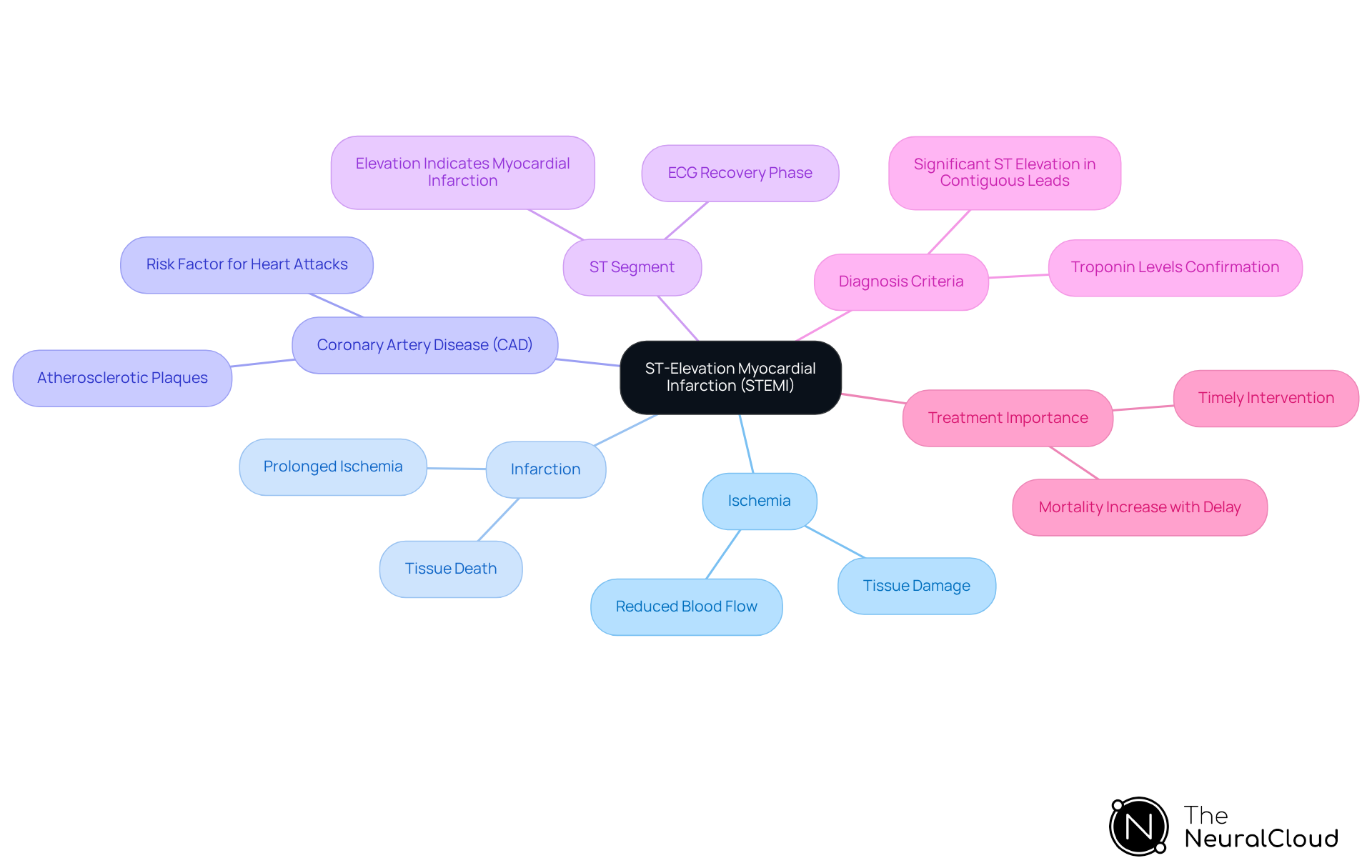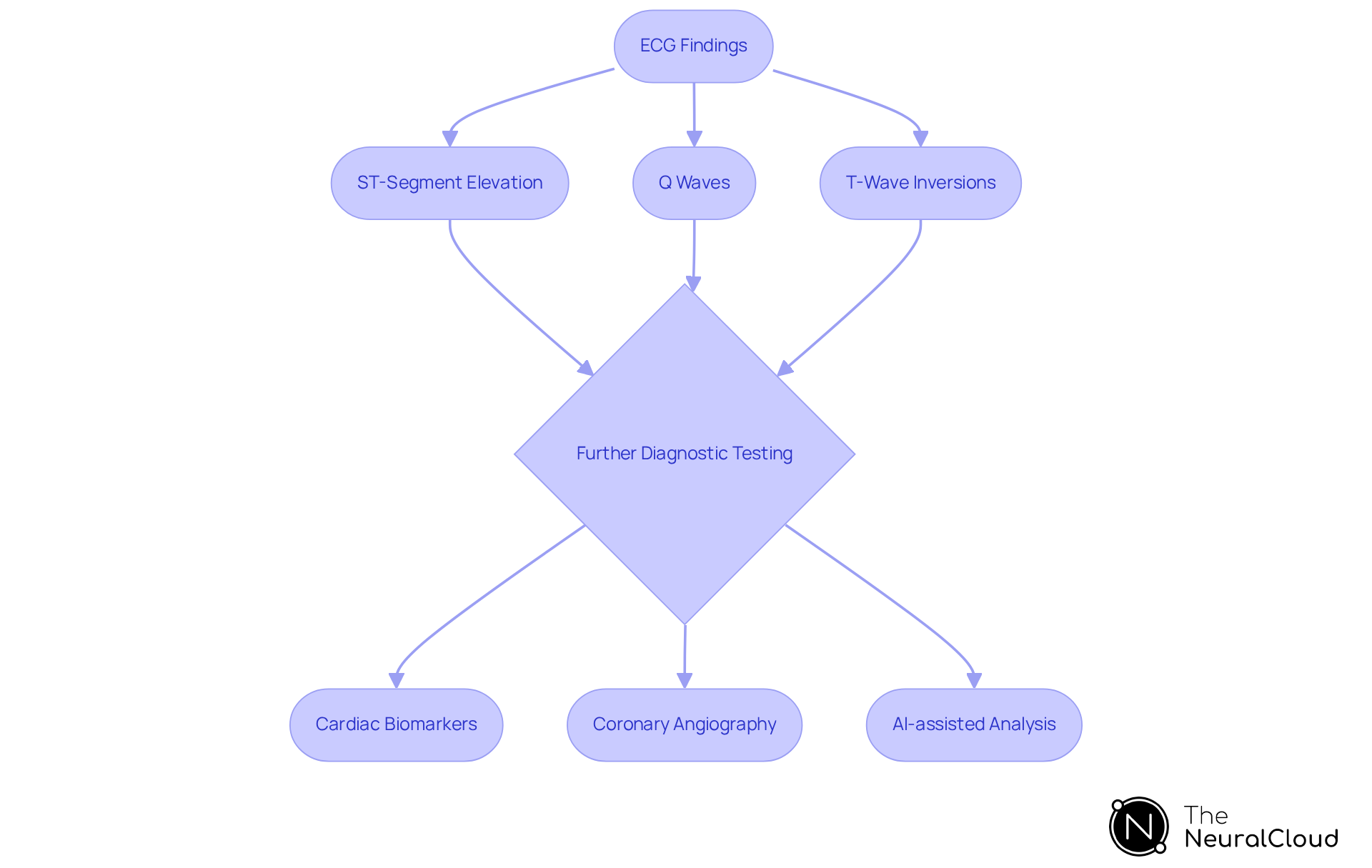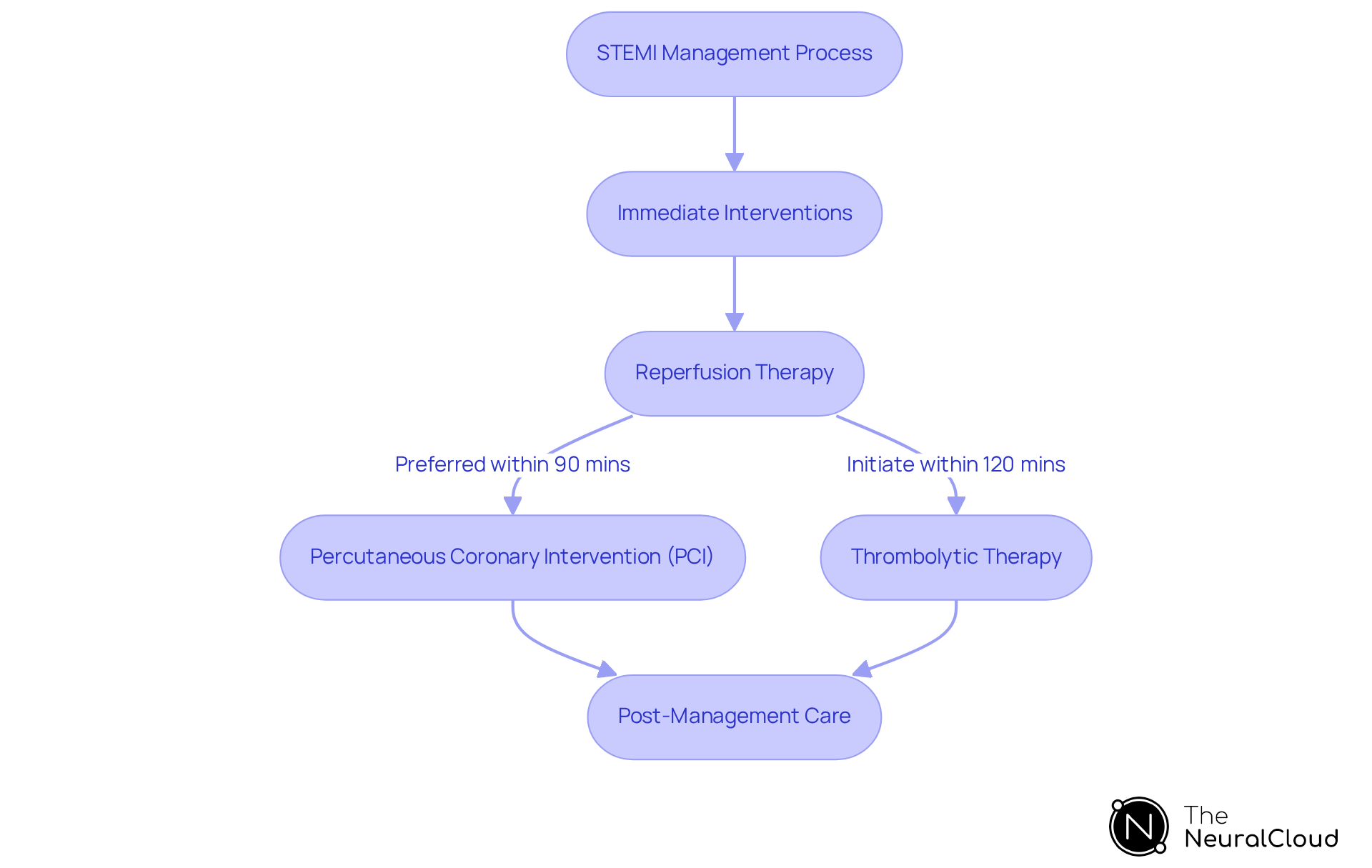Overview
The article provides an overview of the critical aspects of ST-Elevation Myocardial Infarction (STEMI), focusing on its definition, symptoms, diagnosis, and management strategies. It highlights the challenges faced in ECG analysis, emphasizing the need for timely recognition and intervention.
One solution to these challenges is the MaxYield™ platform, which enhances ECG analysis through advanced technologies. This platform offers features such as rapid data processing and improved accuracy in diagnosing STEMI. By leveraging these capabilities, healthcare professionals can make informed decisions more quickly, ultimately leading to better patient outcomes.
The advantages of the MaxYield™ platform extend beyond just improved analysis. With its user-friendly interface and integration into existing workflows, healthcare providers can easily adopt this technology. This seamless integration not only saves time but also reduces the likelihood of errors during diagnosis and treatment.
In summary, the MaxYield™ platform stands out as a vital tool for healthcare professionals dealing with STEMI. By improving ECG analysis and facilitating rapid, accurate diagnoses, it directly contributes to enhanced patient care and outcomes.
Introduction
Understanding ST-Elevation Myocardial Infarction (STEMI) is crucial in cardiology, as this serious condition accounts for a significant percentage of heart attacks. Timely diagnosis and intervention are vital for improving patient outcomes, which means healthcare professionals must be well-versed in the key concepts, symptoms, and diagnostic methods associated with STEMI. However, the complexities of ECG readings and the urgency of treatment can pose challenges.
Advancements in technology, like the MaxYield™ platform, offer promising solutions to enhance the accuracy of STEMI diagnosis and management. This platform streamlines ECG analysis, making it easier for healthcare professionals to interpret complex data quickly and accurately. By improving the precision of ECG readings, MaxYield™ helps in identifying STEMI cases more effectively, ultimately saving lives.
The features of the MaxYield™ platform include:
- Advanced algorithms that analyze ECG patterns
- Real-time alerts for critical changes
- User-friendly interfaces that facilitate quick decision-making
These advantages empower healthcare providers to respond promptly to STEMI cases, ensuring that patients receive the necessary care without delay.
In summary, the MaxYield™ platform not only enhances the diagnostic process but also significantly improves patient outcomes by enabling faster and more accurate interventions. This is essential in the fight against heart attacks, where every second counts.
Define STEMI: Key Concepts and Terminology
ST-Elevation Myocardial Infarction (STEMI) is a serious type of heart attack that is identified by significant ST segment elevation on an ECG. This condition occurs when a coronary artery is completely blocked, leading to considerable damage to the heart muscle. Key terms related to STEMI include:
- Ischemia: Reduced blood flow to the heart muscle, which can cause tissue damage.
- Infarction: Tissue death in the heart due to inadequate blood supply, often resulting from prolonged ischemia.
- Coronary Artery Disease (CAD): The primary condition that increases the risk of heart attacks, characterized by the buildup of atherosclerotic plaques in the coronary arteries.
- ST Segment: A part of the ECG that shows the heart's electrical recovery phase after contraction. An elevation in this segment is a clear sign of a myocardial infarction.
To diagnose ECG STEMI, it is essential that new ST segment elevations are significant in at least two adjacent ECG leads. Understanding these concepts is crucial, as timely diagnosis and intervention can significantly improve outcomes. Research shows that each hour of delay before treatment increases mortality by 10%, highlighting the need for immediate medical attention. Additionally, STEMI now accounts for about 25% to 40% of all acute myocardial infarction cases, reflecting improvements in detection and treatment methods.
The MaxYield™ platform from Neural Cloud Solutions addresses the challenges in ECG analysis by incorporating advanced technologies. Its patent-pending noise filtering and unique wave recognition capabilities enable rapid isolation of critical ECG waves, even in recordings affected by noise and artifacts. This feature enhances the accuracy of ECG readings, allowing healthcare professionals to make informed decisions quickly.
Moreover, the automated labeling of P-Waves and QRS-onsets provides clear inputs that streamline the diagnostic process. This efficiency translates into actionable insights for healthcare professionals, improving patient management. Understanding the terminology and implications of ECG STEMI, along with the capabilities of the MaxYield™ platform, is essential for healthcare providers to ensure rapid response and effective treatment.

Recognize Symptoms: Clinical Presentation of STEMI
The clinical presentation of ST-Elevation Myocardial Infarction (STEMI) can vary among patients, but several hallmark symptoms are commonly observed:
- Chest Pain: Patients often describe this as a sensation of pressure, squeezing, or fullness in the center or left side of the chest, typically lasting more than a few minutes. This symptom is crucial for diagnosis, as it is frequently the first indicator of a heart attack.
- Radiating Pain: Discomfort may extend to the arms, back, neck, jaw, or stomach, which can sometimes lead to misinterpretation of the symptoms as gastrointestinal issues.
- Shortness of Breath: This symptom may occur independently or alongside chest discomfort, indicating potential cardiac distress.
- Other Symptoms: Additional manifestations can include nausea, lightheadedness, and cold sweats, which are often overlooked but can be critical in the context of a heart attack.
Recognizing these symptoms is vital, particularly for ECG STEMI cases, as they necessitate immediate medical evaluation and intervention. Research suggests that prompt treatment can greatly lower mortality rates, with the in-hospital death rate for heart attacks ranging from 4% to 12%. Furthermore, the one-year follow-up mortality rate for severe heart attacks is approximately 10%. Prompt recognition and action can be life-saving, emphasizing the importance of awareness among healthcare professionals and the general public alike.
In addressing the challenges in ECG analysis, advanced AI technology such as MaxYield™ offers significant improvements. This platform enhances the analysis of ECG recordings, particularly focusing on ECG STEMI, providing clearer insights into the presence of heart attack symptoms. By utilizing MaxYield™, healthcare professionals can achieve more accurate diagnoses, leading to timely interventions that can save lives. The benefits of this technology extend beyond immediate analysis, fostering a deeper understanding of cardiac events and improving overall patient outcomes.

Diagnose STEMI: ECG Findings and Diagnostic Testing
Diagnosing ECG STEMI involves a comprehensive analysis of ECG findings along with additional diagnostic tests.
ECG findings show that the primary indicator of ECG STEMI is ST-segment elevation seen in two contiguous leads. Other notable ECG findings may include:
- Q Waves: Indicating a prior myocardial infarction.
- T-Wave Inversions: Suggesting ischemia, which signals potential cardiac distress.
Diagnostic Testing: In addition to the ECG, several other tests are essential for accurate diagnosis:
- Cardiac Biomarkers: Blood tests that measure enzymes like troponin are crucial, as elevated levels indicate damage to the heart muscle. Recent studies show that these biomarkers significantly enhance diagnostic accuracy, especially in the context of ECG STEMI when ECG findings are unclear.
- Coronary Angiography: This imaging technique visualizes blood flow in the coronary arteries, helping to identify blockages that could lead to a heart attack.
The integration of advanced ECG analysis platforms, such as MaxYield™, can greatly streamline the diagnostic process. This platform features noise filtering and automation capabilities, adhering to gold standard methodologies, allowing for rapid and precise identification of critical ECG features. It can process over 200,000 heartbeats in under five minutes, which is vital in emergency situations where prompt intervention can significantly improve outcomes for patients.
Recent findings from the DIFOCCULT-3 trial, the largest AI study in cardiology, underscore the effectiveness of AI-assisted ECG analysis. This study demonstrated a reduction in false-positive activation rates from 41.8% to 7.9% compared to standard methods. Additionally, the AI-assisted arm achieved door-to-balloon times of less than 90 minutes, highlighting the efficiency of AI in emergency settings. Such advancements emphasize the importance of utilizing cutting-edge technology, like Neural Cloud Solutions' MaxYield™, in diagnosing myocardial infarction, ultimately enhancing clinical decision-making and patient care.

Manage STEMI: Treatment Protocols and Interventions
Management of ECG STEMI is a time-sensitive process that focuses on restoring blood flow to the heart muscle, minimizing damage, and improving outcomes. Effective management involves several key components:
-
Immediate Interventions: Administering aspirin and nitroglycerin is crucial for alleviating pain and preventing further clot formation. These medications play a vital role in the acute management of ECG STEMI, helping to stabilize the individual and prepare for subsequent interventions.
-
Reperfusion Therapy: The primary goal is to restore blood flow as quickly as possible, which can be achieved through two main approaches:
- Percutaneous Coronary Intervention (PCI): This minimally invasive procedure is preferred for opening blocked arteries and is most effective when performed within 90 minutes of first medical contact. Timely PCI for patients diagnosed with ECG STEMI significantly reduces mortality and improves recovery outcomes. According to the Society for Cardiovascular Angiography & Interventions, timely reperfusion with primary PCI is linked to better outcomes in cases of ECG STEMI.
- Thrombolytic Therapy: When PCI is not feasible within the critical time frame, thrombolytic agents are administered to dissolve blood clots. However, this therapy must be initiated within 120 minutes of symptom onset to be effective, and careful selection of individuals is essential to avoid complications.
-
Post-Management Care: After initial treatment, individuals typically require continued medications such as beta-blockers, ACE inhibitors, and high-potency statins. These medications are crucial for managing risk factors and preventing future cardiovascular events. For instance, beta-blockers should be continued in all individuals post-myocardial infarction (MI) to reduce the risk of reinfarction and ventricular arrhythmias.
Understanding these protocols is vital for healthcare workers, as prompt and efficient treatment can significantly influence patient outcomes in heart attack cases. Recent studies indicate that early reperfusion therapy is associated with lower rates of major adverse cardiac events (MACE) and improved survival rates, highlighting the importance of rapid intervention in ECG STEMI management.

Conclusion
ST-Elevation Myocardial Infarction (STEMI) is a critical medical emergency that requires immediate recognition and intervention. This article has explored essential concepts surrounding STEMI, emphasizing the importance of understanding its symptoms, diagnostic criteria, and management protocols. The urgency of timely diagnosis and treatment cannot be overstated, as each moment lost can lead to increased mortality and adverse outcomes for patients.
Key insights discussed include hallmark symptoms of STEMI, such as chest pain and shortness of breath, alongside the vital role of ECG findings in diagnosis. The challenges in ECG analysis can hinder swift decision-making in emergency situations. However, the integration of advanced technologies, like the MaxYield™ platform, significantly enhances the accuracy and efficiency of ECG analysis. This platform allows healthcare professionals to respond quickly and effectively when every second counts.
The MaxYield™ platform features advanced algorithms that streamline ECG interpretation, reducing the time needed for diagnosis. By providing clear, actionable insights, it empowers healthcare providers to make informed decisions rapidly. The advantages of using MaxYield™ include improved diagnostic accuracy and enhanced patient outcomes, ultimately leading to better management of STEMI cases.
Effective management strategies, including reperfusion therapy and post-care medications, are crucial in minimizing heart damage and improving patient survival rates. The importance of recognizing and managing STEMI effectively extends beyond individual cases; it reflects a broader commitment to advancing cardiac care. By fostering awareness and utilizing cutting-edge technologies like MaxYield™, healthcare providers can significantly improve outcomes for patients facing this life-threatening condition.
In conclusion, the call to action is clear: prioritize education, swift diagnosis, and timely intervention to combat the challenges posed by STEMI and save lives. By leveraging innovative solutions such as the MaxYield™ platform, we can enhance our approach to cardiac emergencies and ultimately improve patient care.
Frequently Asked Questions
What is STEMI?
ST-Elevation Myocardial Infarction (STEMI) is a serious type of heart attack characterized by significant ST segment elevation on an ECG, resulting from a complete blockage of a coronary artery that leads to considerable damage to the heart muscle.
What does ischemia mean in the context of STEMI?
Ischemia refers to reduced blood flow to the heart muscle, which can cause tissue damage.
What is infarction?
Infarction is the tissue death in the heart due to inadequate blood supply, often resulting from prolonged ischemia.
How is coronary artery disease (CAD) related to STEMI?
Coronary Artery Disease (CAD) is the primary condition that increases the risk of heart attacks and is characterized by the buildup of atherosclerotic plaques in the coronary arteries.
What is the significance of the ST segment in an ECG?
The ST segment is part of the ECG that shows the heart's electrical recovery phase after contraction. An elevation in this segment is a clear sign of a myocardial infarction.
How is STEMI diagnosed using ECG?
To diagnose STEMI, there must be significant new ST segment elevations in at least two adjacent ECG leads.
Why is timely diagnosis and intervention important in STEMI cases?
Timely diagnosis and intervention are crucial because each hour of delay before treatment increases mortality by 10%.
What percentage of acute myocardial infarction cases does STEMI account for?
STEMI accounts for about 25% to 40% of all acute myocardial infarction cases.
What is the MaxYield™ platform?
The MaxYield™ platform from Neural Cloud Solutions addresses challenges in ECG analysis by using advanced technologies to improve the accuracy of ECG readings and enhance the diagnostic process.
What features does the MaxYield™ platform offer to healthcare professionals?
The platform includes patent-pending noise filtering and unique wave recognition capabilities, as well as automated labeling of P-Waves and QRS-onsets, which streamline the diagnostic process and improve patient management.






